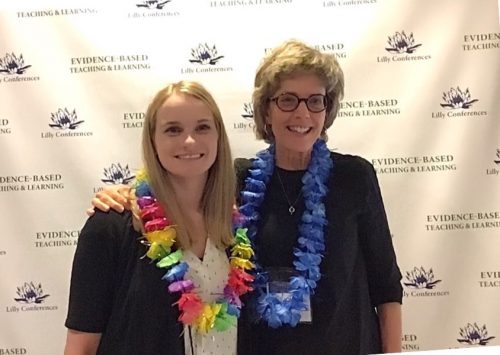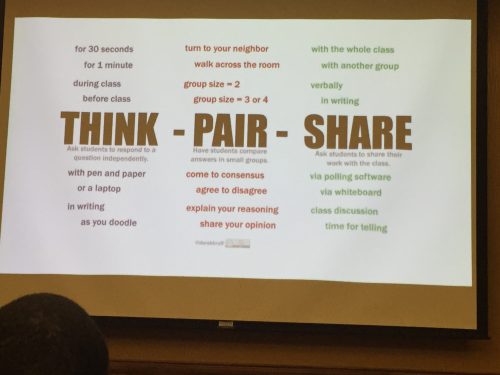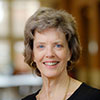This article is more than 5 years old.

This year, Amanda Foster Kaufman and I decided to expand our conference experience by attending the Lilly Conference: Innovative Strategies to Advance Learning which was held August 5-7 in beautiful Asheville, NC (most of the presentation slides are posted through a link on that website). For years, I have been attending LOEX which is the premier library instruction conference, but LOEX offers very few breakout sessions centered around credit-bearing courses. The Lilly Conference is a gem of a conference that focuses on teaching and learning (credit-bearing is assumed!). For three glorious days, Amanda and I sat among professors from a wide variety of disciplines including statistics, chemistry, biology, philosophy, and English (just to name a few). There were 260 attendees from across the United States, including community college, four-year college, medical school, and graduate school faculty.
In the opening session, Todd Zakrajsek, the Conference Director, set the tone for the conference by encouraging us to be kind to the presenters and to stay for each entire session, even if the session was not as great as we thought it should be. He also encouraged us to mingle and to learn from one another. The schedule was jam-packed, but the attendees were unusually kind and they were very open about their desires to be better instructors. A spirit of innovation and experimentation ran throughout the conference.

The schedule for the conference was broken into 50 and 25 minute concurrent sessions with 15 minutes between them. There were 3 plenary sessions (my favorite sessions!) that were an hour and 15 minutes each. By the way, one of the things I learned was that your brain needs an hour to process an hour’s worth of material, so students should not take classes back to back. That also means that we heard far more than we could process!!
Before we attended the conference, we were encouraged to join social media platforms used to push out information to help us prepare for the conference. One of the sources was The Scholarly Teacher blog which became more significant after I attended sessions written by the blog post authors! One of my favorite plenary speakers was Gladys Childs who teaches logic at Texas Wesleyan University. Gladys is a very engaging speaker and she shared some of the methods she has developed over the past 20 years to help her students survive and thrive in this very difficult course. She does not introduce her syllabus until the end of the second week. On the first day of class, she does a magic trick to let the students experience just how awesome she is (and she did one for us!). She spends the first two weeks playing games that introduce logic concepts. This blog post includes most of the content from her session, but she is even more engaging in person!
One of the other plenary speakers was Carl Moore who talked about “Teaching Positively.” The gist of his speech can be found here. He reminded us that the learning environment we create in our classroom impacts our students’ ability to achieve course learning outcomes. He said that teachers have a responsibility to empower learners. Teaching positively relies on the belief that students have boundless potential regardless of their make-up, and it is the responsibility of educators to allow multiple opportunities for those they instruct to be successful and demonstrate their genius. They can do this through intentional learning design, positive learner engagement, and self-care. He emphasized that educators need proper sleep, exercise, nutrition, and engage in mindfulness activities in order to increase oxygen flow to the brain.

I enjoyed attending a session about using white boards to increase student engagement. The session was presented by Alesia Jennings who teaches Chemistry at Western Carolina University. She had us put our names at the top of our white boards and then we answered a series of questions using the boards. The most startling thing for me was that after that session, Alesia would see me at various places throughout the conference and she would call me by name! She has two different size boards that her students can use (she carries them around in a large duffle bag). She uses the white boards every day throughout her course (they draw molecules, formulas, etc.).
Another fun session I attended was by two education professors who use children’s books in their courses to begin discussions on difficult topics such as social justice and history. They introduced 10 children’s books in 25 minutes.
There were many other sessions, but these are just some of the highlights. I’m grateful we had the opportunity to experience a Lilly Conference and I would recommend this conference to anyone looking for ways to create better learning environments in their classrooms!

3 Comments on ‘Joy at the Lilly Conference’
Joy, I need to add the Lily Conference to my list! It sounds excellent. I need to try more whiteboard exercises in my classes. Thanks for sharing!
Glad you were able to see what others nearby are doing.
Wow, this sounds like a wonderful way to spark cross-disciplinary thinking and working (and teaching!). Thanks for sharing, glad it was a fruitful experience so close to home!